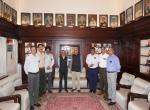Preceding Prime Minister Modi’s contemporary clarion call of ‘Make-in-India’ by half a century, the indigenisation drive first launched by the Indian Navy in the 1960s has, over time, matured into a success story worthy of both adulation and emulation. Often ploughing a lonely furrow as it seemingly marched to the beat of a different drummer, the Navy alone amongst our three defence services has been a true trendsetter of comprehensive indigenisation. The results are impressive across a range of capabilities —from a staggering 119 combat-platforms themselves to their propulsion-cum-generation systems and the state-of-the-art weapon-sensor suites that have made our ships, submarines and aircraft both feared and revered.
This remarkable feat is really the revival of a far older tradition, for India was well-known for its shipbuilding skills some two-centuries ago. In 1817, Mumbai Docks (today the Naval Dockyard) built the Trincomalee — the oldest British warship afloat, which is currently berthed in Hartlepool, UK — and HMS Minden — on which Francis Scott Key composed America’s national anthem, “The Star Spangled Banner” — as also HMS Cornwallis, on which China signed the Treaty of Nanking in 1942, ceding Hong Kong to the British!
The Directorate of Naval Design (DND) has produced as many as 19 different warship-designs — from modest patrol vessels in the 1960s to the formidable destroyers of Projects 15-A and 15-B (the Kolkata Class and the Visakhapatnam Class, respectively), right up to our first indigenous aircraft carrier, the Vikrant, which is currently under construction in Cochin Shipyard. It is a telling fact that even today, neither the Army nor the Air Force has an equivalent design-agency of its own. 2014, which was the DND’s golden jubilee year, saw new ‘Commissioning Pendants’ being flown aboard three different ‘Types’ and ‘Classes’ of the Indian Navy — the Kolkata (the first of a new class of guided-missile destroyers), the Kamorta (the first of a new class of anti-submarine corvettes), and, the Sumitra (the fourth of a new class of Naval Offshore Patrol Vessels). The maturity of indigenised design continues to be strikingly visible, as witness this April’s launch of the stealth-enhanced guided-missile destroyer, the Visakhapatnam — the first of its Class. As things currently stand, Indian shipyards have as many as 41 indigenously designed warships in various stages of construction. These stand testimony to the Indian Navy’s consistent view that indigenisation is a fundamental tenet of its planning and growth. Apart from supporting and encouraging the resurgence of Indian industry, indigenisation also cut costs or dependence levels, both of which translate to significant vulnerability since one has to depend upon imports throughout the life-cycle of the platform and its equipment.
The Navy certainly seems to be acutely aware of the urgent need to incorporate private shipyards into warship-construction and to actively support and, wherever possible, contribute to the modernisation of existing shipyards by adopting modular construction-practices and the preparation of very large pre-fabricated sections. Even with all this, there is a necessity for the country to proactively encourage the creation of ‘green-field’ shipyards, with latest technologies and ship-building techniques/practices.
Between 2005 and 2009, the Navy was in the throes of a process of particularly focussed transformation. In 2006, acutely conscious of the need to stay abreast the gallop of technology and the need to emulate the DND success through matching indigenous capability in terms of shipborne and shore-based equipment, the Indian Navy set-up the ‘Directorate of Indigenisation’ (DOI), in New Delhi, as the nodal directorate for navy-wide indigenisation activities. In so doing, it sent out the unambiguous message that it intends to continue to take advantage of the technological revolution in both, software and production, increasingly establishing itself as a ‘Builder’s Navy’, with attendant spin-offs that would build capacity and enhance capability amongst India’s regional friends and partners. These indigenisation efforts are guided by an ongoing ‘15-year Indigenisation Plan’, covering the period up to 2022, which has been shared with the Confederation of Indian Industry (CII) so as to ensure wide publicity among industry leaders and greater participation from industry. The Navy has also prepared a ‘Science and Technology Roadmap-2025’, aimed at the development of indigenous technology in respect of naval applications. Indian industry is increasingly entering into a number of new and exciting partnerships with global players on the one hand and the Indian Navy, on the other. Top-end examples would include major systems required for aircraft carrier operations, such as Electro-Magnetic Launch Systems, arrestor-wires and aircraft-lifts.
Contrary to the pervasive pessimism that all too often seems to be the staple diet of some segments of the media, the truth is that the Navy’s relentless drive for indigenisation has already yielded impressive and encouraging results in a number of critical war-fighting areas. A number of illustrative examples exist. The DRDO has frequently received adverse media-attention, but it has many success stories as well — at least insofar as the Navy is concerned — and it would be churlish not to acknowledge this. The range of Electronic Warfare Suites such as the revamped ‘AJANTA’, as also the ‘ELLORA’, ‘KITE’, ‘HOMI’ and ‘PORPOISE’, all of which are fitted on the Navy’s latest frontline surface, airborne and subsurface combatants, and which are designed to detect the presence of enemy combatants without disclosing one’s position or identity, are certainly success stories of which we ought to be proud — and these have all been designed by the Defence Electronics Research Laboratory (DLRL), Hyderabad, and are manufactured by Bharat Electronics Limited (BEL). The same is true of the Navy’s advanced underwater-sensors such as the APSOH, HUMSA NG and USHUS family of sonars. These have been developed by the Naval Physical and Oceanographic Laboratory (NPOL), Kochi. Likewise, an indigenous state-of-the-art electro-optical Fire Control System (FCS) the ‘EON 51 Mk II’, designed by IRDE, Dehradun, and productionised by BEL, is now a standard fit. Pitching-in directly with its own formidable developmental expertise, the Navy’s WESEE (Weapons and Electronics Systems Establishment), along with the Centre for Development of Telematics, has rendered yeoman service to the overall indigenisation-effort through its series of world-class ‘Combat Management Systems’ (CMS) and data-link systems (LINK-II Mod 3), now being manufactured by Bharat Electronics Limited (BEL). These form the heart of the entire C4/2SR set-up on board most classes of the Navy’s frontline warships. Likewise, the indigenously designed and developed ‘REVATHI’ three-dimensional ‘Central Acquisition Radar’ (CAR), which is installed aboard the Kamorta Class Anti-Submarine Warfare (ASW) is not only a success story, but is also a good example of the growing ‘Public-Private Partnership’ (PPP) in defence production. The design and production of this radar has been undertaken through a collaborative effort between the Navy, the DRDO and M/s L & T, Mumbai. Similarly, the Indian Navy has partnered GTRE, Bangalore, in ‘marinising’ the ‘KAVERI’ Gas Turbine and will induct at least four units. Deserving of special mention are four indigenously developed system-management suites, viz., the ‘Integrated Machinery Control System (IMCS), the ‘Integrated Bridge Management System’ (IBMS), the ‘Integrated Propulsion Management System’ (IPMS) and the ‘Battle Damage Control System’ (BDCS) that now equip the Shivalik, Kamorta, Kolkata and Visakhapatnam classes of warships, as also the Vikrant. The successful leveraging of Navy-designed IT networks and IT-security platforms stands in sharp contrast to the grave concerns often expressed in respect the country’s remaining critical infrastructure. Even outside of ‘equipment’, there is much to cheer about. The Defence Metallurgical Research Laboratory (DMRL), Hyderabad, in collaboration with M/s Steel Authority of India Ltd (SAIL), and with active participation from the Indian Navy, has successfully undertaken the indigenous development and production of warship-grade ‘DMR249A’ steel plates and bulb structural sections for ship and submarine applications. This represents an enormous step in freeing ourselves from the yoke of pressures and prices associated with the import of steel, as was the norm until very recently. The results are evident in the construction of the Navy’s big-ticket platforms such as the Vikrant and the future submarines being constructed under ‘Project 75-India’. In recognition of the criticality of the PPP-model and guided by the recommendations of the ‘Dr Vijay Kelkar Committee’ that had been set-up to look into the issue of private sector participation in the defence industry, the Navy has taken a number of measures to optimise the potential created by the growing capability of Indian Industry coupled with the shift in Government policy to allow for private partnership in the defence sector. Regular buyer-seller meets and vendor-development programmes are being conducted by nodal organisations within the Navy. The procedures involved in registering as defence vendors are being tweaked to make them both simple and transparent and if the industry is able to adhere to the specifications that are needed and deliver the desired products at competitive prices, there is immense scope for collaboration for mutual benefit.
And yet, although the Indian Navy is an acknowledged pioneer in terms of promoting private participation and private-public partnerships for the induction of equipment, there is much that remains to be done. Where manned and unmanned aircraft are concerned, for instance, the state continues to be grim. While the efforts of HAL can hardly be downplayed, there is a widening gap between the requirement and capability. It is true that the Navy — like its sister services — needs to freeze specifications at a reasonable point in time. It is, however, equally true that the gallop of technology and the telescoping of the point of obsolescence cannot be ignored. What is at stake here is not merely the somewhat esoteric, long-term development of capability, but of real lives that an enemy is actively engaged in attempting to snuff out. Armed combat is brutal, real, and terminal in nature. We cannot afford the luxury of a media-debate when precious lives are at stake. This may sound a trifle dramatic, but it is, nevertheless, a fact that needs to be recognised. As a consequence, there is certainly a need to encourage far greater synergy between the uniformed and civilian segments of the Ministry of Defence and continuously refine the Defence Procurement Procedures.
The current aim of the Navy is to achieve 85% indigenisation through extensive interaction with the Confederation of Indian Industries (CII) and the Organisation of Small Scale Industries (OSSI) to identify the right sources for our equipment. All this notwithstanding, there is no gainsaying the fact that howsoever impressive the advances that have made, the way ahead is still a long and challenging one. The MSME sector is yet to weigh in with its its much vaunted effervescence and this needs to be the Navy’s next focus-area. But that’s a story for another day.
(The writer is a retired Vice Admiral of the Indian Navy)
Published Date: 28th July 2015, Image Source: http://www.thehindubusinessline.com
(Disclaimer: The views and opinions expressed in this article are those of the author and do not necessarily reflect the official policy or position of the Vivekananda International Foundation)








Post new comment